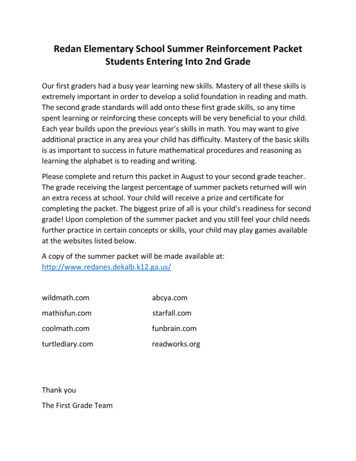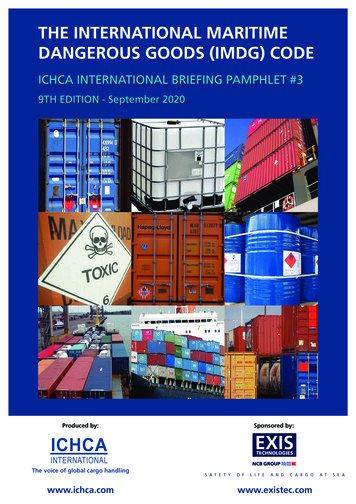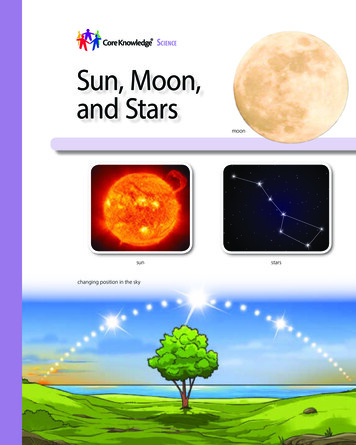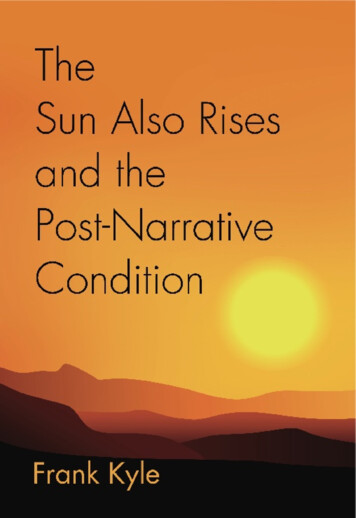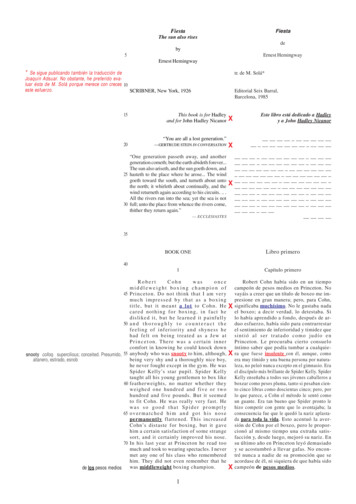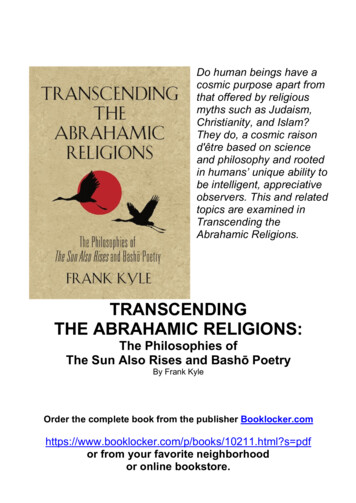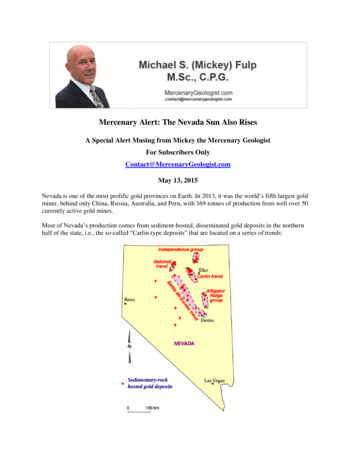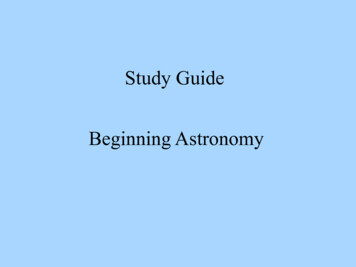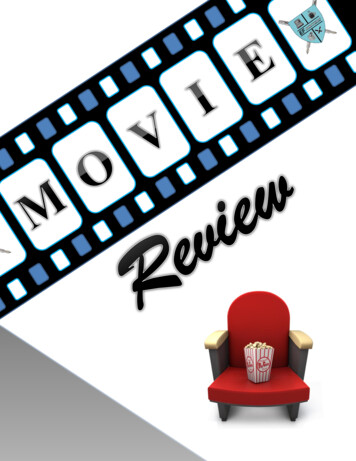
Transcription
Hemingway newslettertheP u b l i c at i o n o f Th e H e m i n g way S o c i e t yAs the Pandemic Ends Yet theWyoming/Montana ConferenceRemains Postponed Until2022 the Hemingway SocietyPrograms a Second StraightSummer of Online Webinars. Only This Time They’reDesigned to Confront theUncomfortable Questions. That’sWhy We’re Calling It:A DangerousSummerIn one of the most powerful passagesin his account of the 1959 bullfightingrivalry between matadors AntonioOrdóñez and Luis Miguel Dominguín,Ernest Hemingway describes returning toPamplona and rediscovering the braveryof a citizenry he had met more than thirtyfive years earlier when first inspired toimmortalize the region in The Sun AlsoRises:“The faces that were young once wereold as mine but everyone rememberedhow we were. The eyes had not changed. No mouths were bitter no matter whatthe eyes had seen. Bitter lines around themouth are the first sign of defeat. Nobodywas defeated.”The quote describes how many feelas fifteen months of pandemic worry andisolation fade amid the Great Reopening.It’s not an overstatement to say livingthrough Covid-19 has posed professionaland personal challenges likely to be thegreatest we face in our lives. And whileit feels good to unmask and re-immerse,we do so with an abundance of caution,the most practical decision of which is topush what was supposed to be our 2020conference, and then our 2021 conference,back another year to July 17-23, 2022.Faced with a second consecutivesummer of plans placed on hold, theboard of the Hemingway Society, underthe advisement of the media committee,Two classic posters from Hemingway’sdangerous summer suggest the spirit of ours:the courage, skill, and grace necessary toconfront the bull. (Courtesy: eBay)has voted to offer a series of webinars fourFridays in a row in July and August. Whilelast summer’s Houseguest Hemingwayprogramming was a resounding success,organizers don’t want simply to repeat lastyear’s model. Led by Hemingway Revieweditor Suzanne del Gizzo, the team takesits inspiration from another significantmoment in The Dangerous Summer whenHemingway lists the “three great requisitesfor a matador”: what is needed is “courage,skill in his profession and grace in thepresence of the danger of death.” A Zoomwebinar may not seem like much of anarena of mortal combat—unless yourInternet connection is wonky—but we dobelieve criticism is an exercise of courage,skill, and grace.Accordingly, please join us for thefollowing:Wednesday, July 14, 1 p.m. EST:Academic writing and publishingwebinar co-sponsored with the F. ScottFitzgerald SocietyThe series kicks off with a webinardesigned to help graduate students andemerging scholars better understand thepublication process of journal articles,monographs, and essay collections.Panelists will include del Gizzo, whohas helmed The Hemingway Reviewfor more than five years now, LeeZimmerman of Hofstra University, editorof Twentieth Century Literature, and No. 73 2021Lynda M. Zwinger, editorof the Arizona Quarterly, aswell as acquisitions editorsAurora Bell (the University ofSouth Carolina Press), JamesW. Long (LSU Press), andadditional special guests.Friday, July 16, 1 p.m.EST: Teaching The Sun AlsoRises, moderated by JulietConwayWe’ll kick off the literarydiscussions with a panel onteaching The Sun Also Rises, moderatedby recent University of EdinburghPh.D. alumna Juliet Conway, who has agreat piece on the novel in the currentHemingway Review. Dig deep intoHemingway’s Lost Generation classic.Whether you’re preparing to teach itor just want to revisit it with fellowaficionados, this session will review thepublication history, reception, and majorcritical approaches that have shaped theway we understand this important work.Panelists: Susan Farrell, Jeffrey HerlihyMera, and Katie Warczak.Friday, July 23, 1 p.m. EST: TeachingHemingway’s Short Stories, moderatedby Frederic J. SvobodaThe editor of Kent State UniversityPress’s excellent Hemingway’s ShortStories: Reflections on Teaching, Reading,and Understanding (2019) will leada roundtable on the advantages andchallenges of including Hemingway’sshort fiction on syllabi of all levels. Doesthe fabled “iceberg theory” resonate withInsideKen Burns and Lynn Novick'sHemingway: Participants, Critics,and Society Members Respond.4Remembering Stresa 2002. 12Interviews. 162020 in Facts and Figures. 23In Memoriam. 302021 No. 73 1
On Being Postponed Again: APre-Post-Pandemic LetterHemingway Society LeadershipCarl P. EbyAppalachian State UniversityPresident (2020-2022)Gail SinclairIndependent ScholarVice President (2020-2023)Verna KalePenn State UniversityTreasurer (2021-2023)Matthew NickelMisericordia UniversityBoard Member (2019-2021)Michael von CannonFlorida Gulf Coast UniversityBoard Member (2020-2022)Kirk CurnuttTroy UniversityBoard Member (2021-2023)Lisa TylerSinclair Community CollegeBoard Member (2020-2021)Suzanne del GizzoChestnut Hill CollegeEx Officio Member, Editor,The Hemingway ReviewJoseph FloraUniversity of North Carolina, Chapel HillEx Officio Member, Past-PresidentCecil PonderIndependentBusiness Systems ManagerSandra SpanierPenn State UniversityDirector, Hemingway Letters ProjectThe Hemingway Newsletter StaffYour Correspondent: Kirk Curnuttkirk.curnutt@gmail.comDesign/Layout: Julene Ewertwww.juleneewert.comjuleneewert@gmail.com2 Hemingway newsletterErnest Hemingway with bull, nearPamplona, Spain. 1927.students today? Do we teach too muchsymbolism or not enough theme? Whatworks work best in the classroom?Should we stick to the classics, orshould we expose novice literaturestudents to the unexpected Hemingwayto upend their stereotypes? Panelists:Ross Tangedal, John Beall, Don Daiker,and Susan F. Beegel.Friday, July 30, 1 p.m. EST:Hemingway and Race, moderated byMarc K. DudleyHow might the Black Lives Mattermovement affect the way we read,teach, and write about Hemingway?Will it? If so, in what ways? Hemingwayand Race is a large and complicatedtopic. Hemingway wrote about Nativepeoples and had a long relationshipwith the Latin world. This panel willfocus primarily on Hemingway’sinteractions with Black people, hisportrayals of Black characters, and hisawareness of and relationship to socialmovements related to race. Panelists:Gary Edward Holcomb, Ian Marshall,Quentin D. Miller, and Peggy WrightCleveland.Friday, August 6, 1 p.m. EST:Hemingway and Sex, moderated bySuzanne del GizzoHow does the #MeToo movementaffect the way we read, teach, andwrite about Hemingway? Gender andsexuality have been defining topicsin Hemingway scholarship for nearlyforty years now, but #MeToo adds newlevels of complexity to that alreadyrich discussion, inviting us to thinkabout the dynamics of sex, seduction,and sexual violence in Hemingway’swork. Panelists include Carl Eby, DebraModdelmog, and Lisa Tyler.We look forward to seeing Societymembers in Zoom one final summerbefore we can reunite in person in2022! Your Correspondent can’t rememberexactly when the Wyoming/Montanaconference was postponed the secondtime. Your Correspondent can’t quiteremember much of what happened thepast fifteen months, to be honest. I doknow I was wrongly accused of punchingMr. F. Scott Fitzgerald in the stomachwith dirty hands by an Internet twerpnamed McSweeney. Which would bea pretty good parlor trick consideringthat Mr. F. Scott Fitzgerald wasn’t evenin the South of France in 1920 whensaid punching was reputed to have takenplace. Your Correspondent wasn’t eitherbut that’s not the point. The point isthat had Your Correspondent knottedMr. Fitzgerald’s innards with a slug hewould have to have long reach. YourCorrespondent does have good reach, buttransatlantic it’s not.Whether Your Correspondentremembers exactly when the Wyoming/Montana conference was postponed asecond time isn’t the point, either. Thepoint is that with the alphabet boys fromthe CDC claiming the virus has beenput down like a shark with a .22 to theforehead it isn’t likely to be postponeda third time. And that means Societymembers need to remember to remakethe arrangements they had made almosttwo years ago when we thought wewere headed there. Housing, travel,registration—it all has to be done over.Your Correspondent recommends gettingthat housing done right away. Word hastrickled down that AirBnBs in CookeCity are already as sparse as my adverbs.You do not want to be the one whoshows up in Yellowstone National Parksaying Well, I’ll be of unsavory parentagebecause I have no place to stay. We do notrecommend camping out that week.You know who does recommend youcamp out?The coyotes, that’s who.So even though if you’re like YourCorrespondent who isn’t exactly rushingto the Internet to book travel whenairlines are full of fistfights and hotellobbies have more conflict than theshores of the Piave in 1918, it’s time to.Reregistration for July 2022, ourpresident reports, will reopen in August.And just to be clear, our presidentis not also president of the Maine TunaClub. How the pandemic affected thatfine organization is a chapter for anotherbook.
2020 Lewis-ReynoldsSmith Founders FellowshipRecipient Iñaki SagarnaDescribes What It’s Like for aPandemic to Upend ResearchPlans—and How PerseveranceUltimately Pays OffWe received the LewisReynolds-Smith FoundersFellowship a month beforethe outbreak of Covid-19. Our goalwas to use the grant to gather extrainformation for an exhibit to openJuly 31, 2020. Thus, after receiving thefellowship, plans were made to visitMadrid, Barcelona, and Salamancalooking for references about the stayof Hemingway in the Basque Country.However, we only made it to Salamanca(the Spanish Civil War archive ishosted there) before the lockdown.Fortunately for us, and thanks to the bigand generous help of the HemingwaySociety, key information was obtainedto make a more comprehensive exhibit.Now that Covid-19 is fadingaway, the Basque Museum of Gernikahas as of March 31, 2021, after along time, opened the postponedexhibit, Hemingway & EuskalHerria. The different panels deal withHemingway’s relationship with theBasque Country, and Basques over thewhole world, including Cuba, Nevadaand Idaho.The Founders fellowship supportwas instrumental to gain extraknowledge on the life of Basquessuch as Juan Duñabeitia, Jose MariaUzelai, and Andres Unzain about theirwanderings after the Spanish Civil War.Once the pandemic is over, we stillhope to go to Madrid and Barcelona. The opening of the Hemingway & Euskal Herria exhibition in late March 2021 atthe Euskal Herria Museum of Gernika-Lumo. Above, the cover of the sixty-four pageexhibit catalog.2021 No. 73 3
The graphics for Ken Burns and Lynn Novick's documentary emphasized a point Societymembers have long understood: Hemingway was a man of words as much as action.(Courtesy PBS)Special Report:The Last Good Life StoryAs the Ken Burns/Lynn Novick DocumentaryHemingway Premieres on PBS, Becoming theLiterary Event of Spring 2021, the Reaction to ItsDetailed, Nuanced Look at the Legend and the ArtDemonstrates that No Two Readers Agree on Howan Icon’s Biography Should Be ToldED. NOTE: The April 5, 6, and 7 premiere of Ken Burns and Lynn Novick’sthree-night, six-hour documentary on Ernest Hemingway prompted morecommentary on the writer than any biography, film, or previously unpublishedmanuscript in recent memory. What was particularly striking was the breadth andvariety of the reaction. The lack of consensus had nothing to do with the quality;reviewers and viewers alike concurred that the mixture of interviews, photography,film clips (Hello, Martha!), and even some inventive animation with manuscriptswas effective. What nobody could quite agree on is who Hemingway was. The rangeof response was particularly apparent when Society members gathered on Zoomon April 10 for a post-watch party with special guest Geoffrey Ward, who wrotethe documentary, in conversation with Krista Quesenberry, Paul Hendrickson, andSteven Florczyk. While the event was cathartic for aficionados just then beginning toventure out after a year in pandemic lockdown, the roundtable also illustrated thatthe Hemingway mystique remains as irresistible and impenetrable as ever. In thisspecial report, we take a peek behind the scenes, survey the critics, and let Societymembers voice their opinions.4 Hemingway newsletterPart I: Familiar Society FacesProve Scholars Can Be asCharismatic and Insightful onthe Screen as Any Talking-HeadSuperstarED. NOTE: Although the documentaryfeatured input from such literaryinstitutions as Edna O’Brien, TobiasWolff, and Mary Karr, among others, formany Society members it was a quartet ofHemingway colleagues who commanded thescreen. We were so impressed we decided toplay four questions with our Fab Four.Susan F. Beegel:How did you prepare for yourinterview?I prepare for interviews while doingthings like prepping dinner, loading thedishwasher, or walking the dog. These aregood times to rehearse in my head answersto the questions I hope I will get asked.When I travel, I take along an excellentpocket chronology of Hemingway’s life byMike Reynolds to read in the airport orhotel room the night before. This quick fixreminds me of episodes and connections itmight be fun to talk about and protects meagainst making errors about dates or otherdetails.
Susan F. Beegel with Burns and producer Sara Botstein.I also carry a copy of Carlos Baker’sLife, still the most accurate, bestdocumented, and easiest-to-use biographyfor rapid reference. The worst mistakeyou can make in an interview is the oneyou don’t realize you’ve made until youget home. All you have to do is say 1925instead of 1926, and you walk out the doorleaving behind a ruined take that mightotherwise have been excellent material,or, worse still, a take with an error thatmakes its way onto national TV with yourname on it. It’s important to be sharp andfresh about details and ready to checksomething if you are unsure and even askfor a redo if need be. With luck, if youreview the night before, you won’t have to.What was your greatest fear goinginto the taping?I’ve done more than a dozen TVdocumentaries and used to compete indebate and extemporaneous speaking,so I relish interviews and was especiallyhonored and excited to be interviewed bysomeone of Ken Burns’s caliber. Nerves area good thing—adrenalin is a performanceenhancing drug, after all—but there’sreally nothing to fear about taping. If yousneeze or your hair falls in your face oryour shirt is buttoned crooked or youbotch a sentence or draw a blank or loseyour voice, the take can be done over oredited out. The entire film crew has yourback. They are watching every detailand want you to look good—and no oneis better at this than the Burns-Novickteam. I mean, the sound guy is looking ata digital readout of your voice that tellshim you need a drink of water before youknow you’re thirsty. You are just having avery intense conversation with one otherperson in a circle of very bright light. Inthis case, that person is Ken Burns, whois a master at relaxing people, drawingthem out, challenging them, and evenbushwhacking them into a good interview.But, if I had one concern going in, itwas the heat. It was 98 degrees in NYC thatday and to film we had to turn off the airconditioning, which was old and noisy. Tothis, add klieg lights. I was worried aboutmaintaining my energy and focus andconcerned about everyone else, too.Was there anything you said thatwhen you watched the documentary youthought “Oh, I mangled that answer” orby contrast, was there a moment whereyou thought, “Hey, I have no memorysaying that but it sounds pretty good”!There are no mangled answers in aBurns-Novick film. The mangled answersare on the cutting room floor. Whatyou see on screen represents just a fewminutes chosen from a much longertaped interview. I was happy with thematerial chosen from my interview—I feellike the best things I said went in, alongwith some more workaday quotationsto help bridge the overall narrative or tocontrast with other speakers’ opinions.Plus, a little kidding around. What wasmost meaningful to me was being used asvoiceover in a place or two. It was specialto see how the directors visualized some ofthe things I spoke about.If you could pick only one word todescribe what it’s like to watch yourselfin a documentary, it would be?Whatever the word is, it’s the same oneyou’d use to describe seeing your writtenwork in print.2021 No. 73 5
Marc K. Dudley (Courtesy: imdb.com)Watching myself in a Ken Burnsproduction was absolutely surreal (myall-encompassing word). I’m thrilled andtruly humbled by the experience. I’vetold both the film’s directors (Ken Burnsand Lynn Novick) that this documentaryexperience (the filming, the consulting, theconversation with so many smart people)has been the most fun I’ve had sincegraduate school.My spotlight moment was surrealto say the least. I was flown to NYC,introduced to what seemed like a dozenfolks on set, was prepped by make-up,and then placed in front of the cameraand the lights (and I thought I heard theword “action”). I taped for over two hours;and I think I spent the better part of thatfirst hour just processing my present-dayreality. I’m still not done processing!Marc K. Dudley:How did you prepare for yourinterviews?How did I prepare for the interview?I didn’t. While I thought of prepping, Ihonestly had no idea where to even begin,so I went in cold, crossing my fingers,insistent on just trying to enjoy themoment. And I did!What was your greatest fear goinginto the taping?That stage-fright would kick in andthat I’d draw a blank when the camerasstarted rolling.Was there anything you said thatwhen you watched the documentary youthought “Oh, I mangled that answer” orby contrast, was there a moment whereyou thought, “Hey, I have no memorysaying that but it sounds pretty good”!I spent a couple of solid hours in thatinterview chair, and I recall talking a greatdeal about race-related matters, some ofthe short stories, and Hemingway’s safaris,but I completely forgot being asked aboutThe Sun Also Rises. Seeing myself for thefirst time on-screen talking about thatnovel was a pleasant surprise!If you could pick only one word todescribe what it’s like to watch yourselfin a documentary, it would be?6 Hemingway newsletterVerna with Hemingway’s favorite presidentat the Museum of Natural History, snappedby Susan on a breakWhat was your greatest fear goinginto the taping?I was afraid I would say somethingfactually wrong or unintentionallyoffensive and disgrace myself.Verna Kale (Courtesy: imdb.com)Verna Kale:How did you prepare for yourinterviews?I re-read my own book as a refresher.I had also already read a draft of GeoffreyC. Ward’s script because I was serving as aprogram advisor, so I had a sense of whatstory the film was going to tell. I went toNew York for several days of meetings withthe filmmakers before my scheduled tapeday. We finished up our meetings early, soI had a day and a half free in New York. Idon’t have a lot of free time in general, soinstead of cramming for my interview, Ienjoyed the chance to go to the Museumof Natural History with Susan Beegel(who took this picture of me and TeddyRoosevelt), to visit the Morgan Library,and to meet up with friends at places thatdon’t have kids meals.Was there anything you said thatwhen you watched the documentary youthought “Oh, I mangled that answer” orby contrast, was there a moment whereyou thought, “Hey, I have no memorysaying that but it sounds pretty good”!I’m in the film really briefly—just afew remarks about Gellhorn. One of thepublic intellectuals I admire most (TressieMcMillan Cottom) tweeted about whatI said, which was kind of my worst fearcome true:But maybe this will motivate me tofinally publish the Gellhorn chapter ofye olde dissertation. Overall though Ireally enjoyed watching the series live andfollowing what people were saying in realtime with the #HemingwayPBS hashtag.It was a communal experience andpeople had some really witty and movingreactions.If you could pick only one word todescribe what it’s like to watch yourselfin a documentary, it would beRecognized.
Miriam Mandel (Courtesy: imdb.com)Miriam Mandel:How did you prepare for yourinterviews?I got to know Lynn beforehand.My part was filmed in Paris at the 2018Hemingway Conference. Lynn came acouple of times to my hotel, before theinterview, and we met and had coffee andtalked and talked: she is a tremendouslyengaging person, a great listener, an openand intelligent speaker, and just fun to bewith. In no time at all we had exchangedfamily histories and partner stories. By thetime the day of the filming came around,I felt we knew each other very well andcould talk easily.On the appointed day I went over toher hotel, where the crew was, with mysilver earrings and my very best littleblack frock carefully rolled up in a paperbag. Lynn nixed the frock but allowed theearrings. She then turned me over to themakeup woman, who made me feel likea movie star by brushing blush here anddrawing smudgy blue lines there, and thenI was cautioned to step carefully over abunch of cables and wires that decoratedthe floor between me and the chair I wasto occupy. I clutched my very worn copy ofDeath in the Afternoon hoping to be askedto read from it. I don’t remember if I was.What was your greatest fear goinginto the taping?That I would sound stilted. But Lynnmade sure I didn’t. She sat across fromme and the conversation began. It was themost natural and easygoing conversationyou can imagine, and although there was alighting person there, and a sound person,and a make-up person (who stopped theproceedings at one point because my leftear had gotten too shiny and needed tobe powdered), and a lot of equipment, theonly thing that mattered was Lynn’s face.She not only asked wonderfully intelligentquestions, she responded to my answerswith her mobile face, so that I couldn’thelp but remain focused on her. I thinkher expressions conducted my answers,managed the tempo, created emphases,and elicited emotion, much as ZubinMehta’s eyes and face and hands do whenhe conducts the Israel Philharmonic. It wasa wonderful conversation, guided by thatexpressive face of hers. I don’t rememberhow long it lasted, but I do remember thatI enjoyed myself, the way one does whena class goes well, when you know that realcommunication has taken place, when youfeel that understanding has occurred andinsights have been achieved. It was thatkind of a high.Was there anything you said thatwhen you watched the documentary youthought “Oh, I mangled that answer” orby contrast, was there a moment whereyou thought, “Hey, I have no memorysaying that but it sounds pretty good”!For two years I didn’t know if all thatfun had ended up in film or on the cuttingfloor. Sandy Spanier and Verna Kale, whowere advising the documentary team andsaw previews, at one point told me I wasin, or at least had been in, in the versionthey saw. Seeing the documentary itselfwas exciting, waiting to see if I indeed wasin it, and when and where I would showup. And yes, there I was, with my makeupand silver earrings, my little black frockand my very worn copy of Death in theAfternoon nowhere to be seen.If you could pick only one word todescribe what it’s like to watch yourselfin a documentary, it would beOdd. Watching myself was an oddexperience—odd but oddly pleasant. Evenodder was hearing myself before I wasactually on screen, as happens a couple oftimes in the documentary.There were a goodly number of emailsthat came to me after the documentary,some from high school friends of longago asking if that was me, and one veryinteresting missive from someone whoresponded to my accent, saying it filledhim with nostalgia: he was a Cuban whohad come to Puerto Rico, had gone to thesame school I went to, and had had hisBar Mitzva in the synagogue my parentshelped establish and in which I wasmarried. Someday I hope to meet him andsee what his accent sounds like.Most of all, though, I hope to meet upwith Lynn again and pick up where weleft off. She is a terrific interviewer and,most of all, a terrific conversationalist. InHemingway, she and Ken Burns and theirtalented team brought forth a beautifuland sensitive documentary, makingwriting and even thinking come alive,and avoiding all pitfalls, pathos, andstereotypes. My admiring congratulationsto them all.Part II: The Man in theMirror: Despite an Aggregated89/100 Score on Metacritic.com, Hemingway Provesthat Reviewers RemainWildly Conflicted about theWriter’s Accomplishments andRelevance why a film about Hemingway now,and not, say, Faulkner? Is Faulkner nota more vibrant figure, who prefigured inhis Snopes stories and novels the age ofTrump and Derek Chauvin’s trial, andthe Gordian knot of race that continuesto choke large portions of our country?In this context, Burns and Novick’sHemingway feels a little anachronistic, and“smells of the museums,” as Stein once saidof Hemingway. Stein’s voice and her experiments withsound are part of the spine of his work,and how gripping is that? To realize thatHemingway’s famously muscular prosewas born of admiration for a middleaged lesbian’s sui-generis sentences andparagraphs? Absorbing Stein’s influence,and admitting to his attraction, was oneway of getting at what he always longedfor: to be a girl in love with a powerfulwoman. —Hilton Als, The New YorkerWhatever you already know, or don’tknow, about Ernest Hemingway andhis work—and his life—the new PBSdocumentary Hemingway is certain to addmore to that body of knowledge. And, verylikely, it will make you reassess much ofit. As a Ken Burns and company literarybiography, Hemingway is even better thantheir previous documentary on MarkTwain. And my levels of praise don’t getmuch higher than that.—David Bianculli, NPR2021 No. 73 7
Most surprisingly, the documentaryshows a man who—far from being a relicof the past—is instead an avatar for the21st century, with the narrative coalescingaround themes near and dear to themillennial heart: gender inequity, mentalhealth, and the thirst for fame.—Brin-Jonathan Butler, Bloomberg.comIt’s not that the documentary isuninformative—Burns and Novick seemto have access to every pertinent location,letter, photo, film clip, and intervieweerelated to their subject. But the overalltone and approach tends to remain nomatter what the subject, whether it’s theCivil War, jazz, baseball, the Dust Bowl,or Ernest Hemingway. As always, there’sPeter Coyote’s warm narration, elegiacmusic, and a fairly simple narrative arc.What it adds up to, though, is a tendencytoward depoliticization, but by now Burnsis renowned for his ability to sand offthe spikier, more interesting parts of hissubjects. —Eileen Jones, Jacobin an engaging and beautifullyconstructed character study and proof thatwhatever [Ken] Burns chooses to cover asa filmmaker will more than likely becomethe definitive documentary on that specifictopic. In Hemingway’s case, it’s a story thatis a lot more sensitive than one could’veimagined. —Kiko Martinez, VarietySo what can Hemingway tell usabout what American writers owe toHemingway? Whatever that debt is, it’s alot, according to the various writers andliterary scholars who appear as talkingheads in the documentary, but they (EdnaO’Brien, Tobias Wolff, Mario Vargas Llosa)are fairly long in the tooth, and few young8 Hemingway newsletterAs The New Yorker’s illustration to Hilton Als’s review suggested, most critics strove todiscover the 7/8 of Hemingway hidden beneath the surface. (Courtesy: The New Yorker)fiction writers would now claim himas a star to steer by. In comparison, theinfluence of William Faulkner, transfiguredin the crucible of Toni Morrison’s geniusand legacy, can be detected everywhere.—Laura Miller, SlateHemingway is unmistakably an attemptto reassert the author’s place in the 20thcentury literary canon, but Burns andNovick do not shy away from telling youthings that may—and in my case definitelydid—move you toward the conclusion thatHemingway was more problematic thanmany celebrities who have been “canceled”in recent years. Midway through watchingthe series, I wrote in my notes, “I’mstarting to get the sense that Burns andNovick don’t like Hemingway either.”When the facts are bad enough, objectivitybecomes its own judgment. —Scott Porch,The Daily BeastPart III: Several ReadersWrite: Society Members WeighIn, Respectful but Varied inReactionI would like to see more aboutMichigan, Arkansas and the Americanwest. —Pat AtwaterI recall the comment that amongEnglish language writers only Shakespearehas had more written about him thanhas Ernest Hemingway. And why not?Hemingway made his work out of his life.He also sought experiences, rich in theirown right, which would serve as fodderand he invited his contemporaries to viewhis work in that context. The brilliance ofthe documentary was in showing how thethemes of war, death, love and nature, soprominent in his work, were embedded inthese life experiences. —William Berg
My reaction to the Ken Burns / LynnNovick Hemingway documentary ismixed. The main issue is, for those thathave studied Hemingway for any lengthof time, the documentary was necessarilyincomplete – at six hours. So, what toinclude? On one hand, the portions thatfocused on the writing were very effective,but again, excluded, or too quicklyskimmed over some key works. On thepersonal front, they took a necessarilyunvarnished look at his complicated life,but again, that should still flow naturallywithin the confines of the film. At a coupleof key moments, it did not. For example,there was a random clip of Patrick statingthat his father didn’t care much aboutthe Cuban people, so that’s what a viewermay come away with. This is contradictedby the recent book, Ernesto by AndrewFeldman. The film also emphasizes a laterin life letter regarding James Jones whicharbitrarily attem
EST: Teaching The Sun Also Rises, moderated by Juliet Conway We’ll kick off the literary discussions with a panel on teaching The Sun Also Rises, moderated by recent University of Edinburgh Ph.D. alumna Juliet Conway, who has a great piece on the novel in the current Hemingway R
